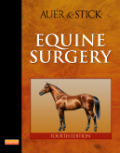
The most comprehensive reference available on equine surgery, this book prepares the veterinary surgeon for managing each surgical condition by understanding its pathophysiology and evaluating alternative surgical approaches. Explanations describe how to avoid surgical infections, select and use instruments, and perfect fundamental surgical techniques including incisions, cautery, retractions, irrigation, surgical suction, wound closure, dressings, bandages, and casts. ÍNDICE: Section I: Surgical Biology 1. Shock: Pathophysiology, Diagnosis, Treatment, and Physiologic Response to Trauma 2. Systemic Inflammatory Response Syndrome 3. Fluids, Electrolytes, and Acid-Base Therapy 4. Hemostasis, Surgical Bleeding, and Transfusion 5. Wound Repair 6. Metabolism of the Surgical Patient and Nutritional Support 7. Surgical Site Infection and the Use of Antimicrobials 8. Regenerative Medicine Section II: Surgical Methods 9. Sterilization and Antiseptics 10. Preparation of the Surgical Patient, the Surgery Facility and the Operating Team 11. Surgical Instruments 12. Surgical Techniques 13. Minimally Invasive Surgical Techniques 14. Cryosurgery 15. Lasers in Veterinary Surgery 16. Suture Materials and Patterns, Tissue Adhesives, Staples, and Ligating Clips 17. Drains, Dressings, and External Coaptation Section III: Recent Advances in Anesthesia 18. Balanced Inhalation Anesthesia 19. Modern Injection Anesthesia for Horses 20. Anesthesia and Analgesia for Foals 21. Recovery from Anesthesia 22. Chemical Restraint for Long Standing Surgery 23. Pain Management Section IV: Integumentary System 24. Principles of Reconstructive and Plastic Surgery 25. Skin Grafting 26. Management of Superficial Wounds 27. Management of Deep and Chronic Wounds 28. Management of Sinus Tracts and Fistulas 29. Skin Conditions Amenable to Surgery Section V: Alimentary System 30. Oral Cavity / Salivary Glands 31. Esophagus 32. Stomach and Spleen 33. Colic: Diagnosis, Surgical Decision, and Preoperative Management 34. Surgical Approaches tothe Abdomen 35. Principles of Intestinal Surgery and Determination of Intestinal Viability 36. Small Intestine 37. Large Intestine 38. Rectum and Anus 39. Abdominal Hernias 40. Postoperative Care, Complications, and Reoperation Section VI: Respiratory System 41. Overview of the Upper Airway Function 42. Diagnostic Techniques in Equine Upper Respiratory Tract Disease 43. Nasal Passages and Paranasal Sinuses 44. Pharynx 45. Larynx 46. Guttural Pouch 47. Trachea 48.Thoracic Disorders Section VII: Nervous System 49. Anatomy and Physiology of the Nervous System 50. Diagnostic Procedures 51. Developmental Vertebral Anomalies 52. Surgical Treatment of Developmental Diseases of the Spinal Column 53.Surgical Treatment of Traumatic Disorders of the Spinal Column 54. PeripheralNerve Injury Section VIII: Eye and Adnexa 55. Surgery of the Globe and Orbit 56. Adnexal Surgery 57. Surgery of the Ocular Surface 58. Intraocular Surgery Section IX: Reproductive System 59. Testis 60. Penis and Prepuce 61. Vulva, Vestibule, Vagina and Cervix 62. Uterus and Ovaries Section X: Urinary System 63. Diagnostic Techniques and Principles of Urinary Tract Surgery 64. Kidneys and Ureters 65. Bladder 66. Urethra Section XI: Diagnostic Imaging Examination 67. Radiography 68. Ultrasonography 69. Nuclear Scintigraphy 70. Computed Tomography 71. Magnetic Resonance Imaging Section XII: Musculoskeletal System 72. Diagnostic Anesthesia 73. Emergency Treatment and Transportation of Equine Fracture Patients 74. Bone Biology and Fracture Healing 75. Metallic Instruments and Implants 76. Principles of Fracture Treatment 77. Bone Grafts and Bone Replacements 78. Synovial Joint Biology and Pathobiology 79. Medical Treatment of Joint Disease 80. Surgical Treatment of Joint Disease 81. Arthrodesis Techniques 82. Management of Bursitis 83. Diagnosis and Management of Tendon and Ligament Disorders 84. Biology, Diseases and Management of Muscle Disorders 85. Synovial and Osseous Infections 86. Angular Limb Deformities 87. Flexural Deformities 88. Osteochondrosis 89. Subchondral Bone Cysts 90. Foot 91. Phalanges andthe Metacarpophalangeal and Metatarsaophalangeal Joints 92. Third Metacarpal / Metatarsal Bones 93. Vestigial Metacarpal/Metatarsal Bones 94. Carpus 95. Radius and Ulna 96. Shoulder 97. Tarsus 98. Tibia 99. Stifle 100. Femur and Pelvis 101. Temporomandibular Joint 102. Craniomaxillofacial Disorders 103. Postoperative Physiotherapy for the Orthopedic Patient
- ISBN: 978-1-4377-0867-7
- Editorial: Saunders
- Encuadernacion: Cartoné
- Páginas: 1552
- Fecha Publicación: 05/12/2011
- Nº Volúmenes: 1
- Idioma: Inglés
- Inicio /
- /
